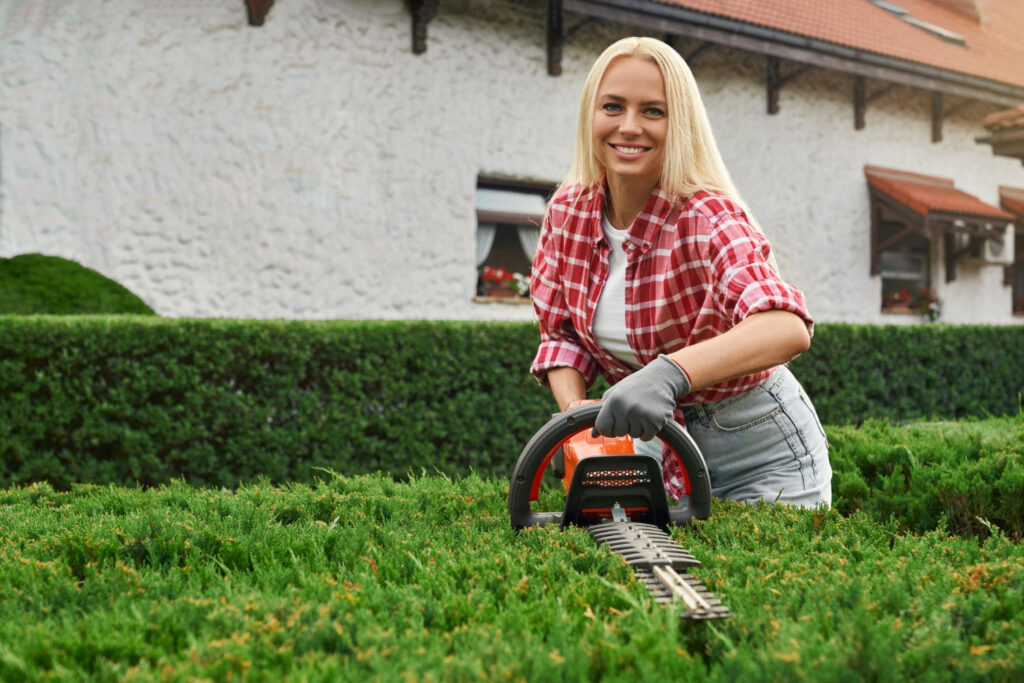You mow regularly. The grass is green, trimmed, and neat. But somehow, it still looks off. Not quite finished. Almost like something’s missing.
That’s because something is missing, and it’s likely a weed eater.
Even a freshly mowed lawn can look scruffy around the edges if you don’t clean up the details. A weed eater, also called a string trimmer, gets into all the tight spots your lawn mower simply can’t reach. It’s the difference between “neatly cut grass” and a truly polished yard.
Table of Contents
Mowing Only Handles Half the Job
Think about where your lawn mower struggles. Areas near fences, around flower beds, under benches or decks, along sidewalks, and against trees — none of these get a proper trim from a regular mower. The wheels can’t get close enough, and even if they could, the blade design just isn’t made for precision edging.
So what happens? Tall blades and weeds start to pop up in these overlooked areas. It makes the entire lawn feel uneven, no matter how much effort you put into mowing the main sections.
A weed eater solves that by cutting down growth in those problem spots. It acts like a fine-detail brush for your yard, trimming where mowers can’t and bringing everything to a clean, finished level.
The Visual Impact Is Immediate
There’s a clear difference between a lawn that’s just been mowed and one that’s been trimmed too. That neat, uniform line where your grass meets the driveway? That only happens with a weed eater. Without it, you get overgrowth spilling out, rough edges, and an overall messier look.
It’s similar to getting a haircut and skipping the neckline clean-up. Technically, it’s done, but it doesn’t look sharp.
Well-trimmed edges make the space look bigger and more intentional. It also creates stronger contrast between your lawn and hardscaping, which helps every feature of your yard stand out more clearly.
Not Just for Looks — It Helps Lawn Health
A tidy lawn isn’t only about curb appeal. Regular trimming actually contributes to the overall health of your grass and plants.
When you allow weeds and tall grass to grow unchecked around the edges, those areas become breeding grounds for pests and disease. They also block airflow and sunlight from reaching the base of your grass or flowers, especially in beds and border zones.
Here’s what happens when those edges are left to grow wild:
- Increased weed spread – Weeds growing unchecked at the edges can quickly spread to your lawn.
- Water blockage – Overgrowth can block sprinklers or create runoff problems.
- Damage to trees and structures – Weeds rubbing against trees, fences, or siding can cause long-term damage.
By trimming regularly, you reduce these risks and create a cleaner, healthier growing environment.
One Tool, Several Uses
A good weed eater doesn’t just cut weeds. It’s a multipurpose tool that gives you more control over how your outdoor space looks and functions. Depending on the model, you can use it for edging, clearing overgrown areas, and shaping patches of grass.
Here’s how a weed eater adds value beyond basic trimming:
- Edge Definition – Flip the trimmer vertically and use it to create crisp lines along sidewalks, patios, or flower beds.
- Pathway Clearing – It’s perfect for cutting through tall grass along footpaths or fence lines.
- Touch-up Work – Use it between mower runs to handle quick spot fixes after rain or uneven growth.
Mowers are great for covering ground fast. But when it comes to details, the weed eater is what lets you really shape and define your yard.
Saves Time and Effort Long-Term
It might seem like one more step in your lawn routine, but trimming with a weed eater can actually save you time in the long run. Tackling weeds and overgrowth while they’re still small is far easier than dealing with thick patches later. It also means less raking, less digging, and fewer hours spent reclaiming overrun corners.
Plus, once you’ve gotten into the habit of trimming regularly, it becomes a quick add-on to mowing. No more struggling with hand clippers or trying to reach tough spots with awkward angles. It’s faster, cleaner, and much less frustrating.
How Often Should You Use It?
If you’re already mowing weekly or biweekly, it’s smart to trim at the same time. The longer you wait, the tougher the growth becomes. Waiting also gives weeds a chance to settle in and spread.
In dry seasons or cooler months, you might be able to stretch it to every other mow. But during peak growth periods, regular trimming is what keeps everything looking under control.
Simple Fix, Huge Upgrade
Sometimes people assume that adding another tool to their yard work means extra hassle or cost. But weed eaters are lightweight, simple to use, and surprisingly efficient. Most take just a few minutes to trim the edges of an average lawn, and that short time makes a huge difference in how finished the yard looks.
It’s not about making the job longer. It’s about making the result worth your effort.
Where Lawn Pride Really Shows
Your lawn doesn’t have to be huge or professionally landscaped to look good. Even a small yard can feel like a personal retreat when it’s well-kept. And a weed eater plays a big role in that.
It shows attention to detail. It shows that you care not just about the lawn itself, but the full picture: the edges, the transitions, the final impression.
If something has felt off about your yard and you couldn’t put your finger on it, this might be the missing piece.
A Finishing Touch That’s Worth It
There’s nothing complicated about it. If you want your yard to look complete, clean, and cared for, a weed eater belongs in your routine. It’s not an extra. It’s essential.
Trim the edges. Clean the borders. Keep those problem spots under control. You’ll see the difference right away, and so will everyone else.
